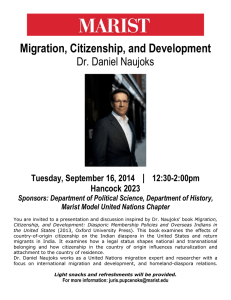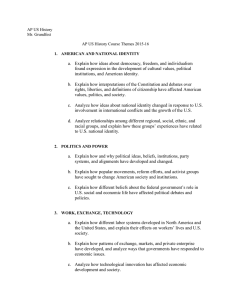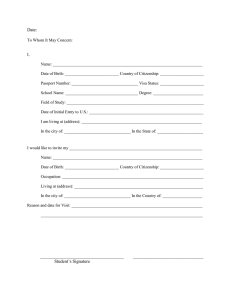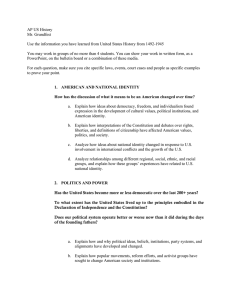Ethnic diversity and schooling in national education systems: Issues
advertisement
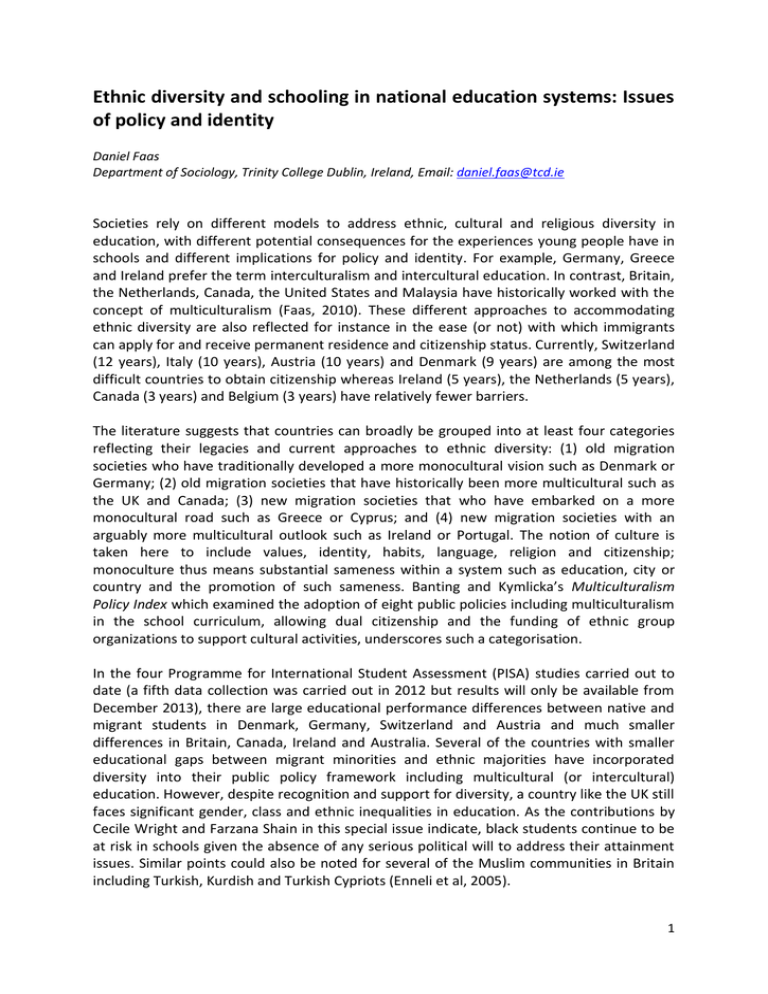
Ethnic diversity and schooling in national education systems: Issues of policy and identity Daniel Faas Department of Sociology, Trinity College Dublin, Ireland, Email: daniel.faas@tcd.ie Societies rely on different models to address ethnic, cultural and religious diversity in education, with different potential consequences for the experiences young people have in schools and different implications for policy and identity. For example, Germany, Greece and Ireland prefer the term interculturalism and intercultural education. In contrast, Britain, the Netherlands, Canada, the United States and Malaysia have historically worked with the concept of multiculturalism (Faas, 2010). These different approaches to accommodating ethnic diversity are also reflected for instance in the ease (or not) with which immigrants can apply for and receive permanent residence and citizenship status. Currently, Switzerland (12 years), Italy (10 years), Austria (10 years) and Denmark (9 years) are among the most difficult countries to obtain citizenship whereas Ireland (5 years), the Netherlands (5 years), Canada (3 years) and Belgium (3 years) have relatively fewer barriers. The literature suggests that countries can broadly be grouped into at least four categories reflecting their legacies and current approaches to ethnic diversity: (1) old migration societies who have traditionally developed a more monocultural vision such as Denmark or Germany; (2) old migration societies that have historically been more multicultural such as the UK and Canada; (3) new migration societies that who have embarked on a more monocultural road such as Greece or Cyprus; and (4) new migration societies with an arguably more multicultural outlook such as Ireland or Portugal. The notion of culture is taken here to include values, identity, habits, language, religion and citizenship; monoculture thus means substantial sameness within a system such as education, city or country and the promotion of such sameness. Banting and Kymlicka’s Multiculturalism Policy Index which examined the adoption of eight public policies including multiculturalism in the school curriculum, allowing dual citizenship and the funding of ethnic group organizations to support cultural activities, underscores such a categorisation. In the four Programme for International Student Assessment (PISA) studies carried out to date (a fifth data collection was carried out in 2012 but results will only be available from December 2013), there are large educational performance differences between native and migrant students in Denmark, Germany, Switzerland and Austria and much smaller differences in Britain, Canada, Ireland and Australia. Several of the countries with smaller educational gaps between migrant minorities and ethnic majorities have incorporated diversity into their public policy framework including multicultural (or intercultural) education. However, despite recognition and support for diversity, a country like the UK still faces significant gender, class and ethnic inequalities in education. As the contributions by Cecile Wright and Farzana Shain in this special issue indicate, black students continue to be at risk in schools given the absence of any serious political will to address their attainment issues. Similar points could also be noted for several of the Muslim communities in Britain including Turkish, Kurdish and Turkish Cypriots (Enneli et al, 2005). 1 The work of Koopmans et al (2005, 2012) is also indicative of the range of national policypractice links, arguing that cross-national differences continue to exist due to different historical legacies and that these have not become smaller over the past three decades. While they found divergences across societies in terms of citizenship acquisition, family reunification, access to public service employment, political rights, educational and other cultural rights, the only convergence was around anti-discrimination and expulsion. For example, Athens continues to be the only capital in Europe without a mosque despite yearlong debates about feasibility and geographical location of a mosque (Triandafyllidou and Gropas, 2009). Several contributors in this special issue including Yvonne Leeman and Sawitri Saharso as well as Farzana Shain offer a historical assessment of Dutch and British attempts to dealing with migration-related diversity. Furthermore, Faas (2011) who compared the geography, history and citizenship education curricula in Greece, Germany and England, argued that the relationship between national and European identities and multicultural values was rather different and dependent on the school subject. Whilst history was found to be ethnocentric in all three countries – albeit to varying degrees – Greek geography and citizenship curricula veered between ethnocentrism and Europeanism. In contrast, in England, macro-political notions of multicultural Britishness were reinforced in geography and citizenship education. Following national political trends, German curricula privileged national and European topics, but attempts were made to address ethnic and cultural diversity, particularly in geography. The contributions in this special issue draw on a range of theoretical approaches and methodologies. For example, Cecile Wright draws on a critical theoretical framework to empower African Caribbean students in the UK similar to the critical policy approach by Gulson and Webb which is attendant to how power issues affect the production and subsequent enunciations of different discourses. Coulby and Jones (1995) suggest that there is a link between how national education systems appear to reproduce, eliminate and exploit diversity, and postmodernity. Postmodernity ‘has shifted from being a way of describing cultural products (allusive, disjointed, pastiche, merging subjectivities) to a way of describing society (fractured, relative, pluralistic, gendered)’ (ibid: 3), reflecting the ways in which a society has shifted from notions of capitalism to information and knowledge. For Coulby and Jones, modernist knowledge is mainly white, Western knowledge; it is primarily associated with the concept of nationalism as well as a subject-based teaching approach rather than an integrated multicultural curriculum. By contrast, according to Coulby and Jones, post-modernist knowledge, acknowledges not only the international contribution to European civilisation but also that European knowledge systems themselves must be placed within a global context. This is why two articles in this issue are dedicated to aspects of gender and race equality in education beyond Europe: Canada and Kurdistan-Iraq. Reflections on the contributions in this special issue The contributions included in this special issue include old migration host societies (UK, Netherlands, France and Canada) and new migration destinations (Cyprus, Ireland, Malta and Kurdistan-Iraq). The texts illustrate cases where assimilationist tendencies and minimalist approaches to diversity have dominated public and educational discourses such as in Malta (Mary Darmanin) and Cyprus (Christina Hajisoteriou and Panayiotis Angelides). It is important to note, however, that there is variation in responding and managing diversity 2 not just between old and new host states but also among old and new host states and the contribution by Nathalie Rougier powerfully demonstrates how the Irish case differs from other small new migration destinations such as Cyprus and Malta. At the same time, there are striking similarities around notions of religion with regard to national identity, be it Catholicism in Malta and Ireland or Orthodoxy in Cyprus, which has made it somewhat difficult to reconceptualise national identities along more pluralistic lines. The ‘smallness’ of several cases in this special issue often appears to play an important role with regard to reinforcing national values and identities in education and society at large. One interesting theme raised in a number of contributions is the issue of school choice. For example, Gulson and Webb argue that school choice policies can enable the development and establishment of ethno-centric schools and curricula based on ideas of identities and recognition. They illustrate this by drawing on the establishment of an Africentric school in Toronto. Such school choice policies and alternative schools that educate small numbers of students may be limited in providing mechanisms to address historic inequalities. It is often white middle-class parents and students that are the main beneficiaries of school choice policies. Reay et al (2008) discuss this aspect further and found that middle-class families felt passionate about the need to produce tolerant children and thus chose to send their children to inner-city comprehensive schools in London ‘providing multicultural experiences that home life cannot’. However, while Reay’s parents valued the ‘ethnic other’, many parents feared the ‘working-class other’ (Reay et al. 2007). This reminds us of the importance of class, particularly in the UK, and specifically what Reay et al. (2008: 240) referred to as ‘the socially inclusive middle class as opposed to Gidden’s (2000) [idea of the] socially exclusive middle class’. The ‘socially inclusive middle-class’ student and family actively embraces and chooses diversity and is open to difference. Similarly, Cecile Wright in her contribution concludes that a market orientation based on ‘choice’ and competition as we have seen it in the UK leads to the exacerbation of class and racial inequalities with the elites not contemplating the state education system for their children. Another cross-cutting theme relates to educational attainment of migrant children and factors affecting achievement. For example, Gulson and Webb in their paper on Canada address the educational disadvantages of Black students similar to Cecile Wright who argues that neoliberal policies in the UK enhance inequalities. Schnell et al in their paper on France and the Netherlands discuss individual and institutional factors and determinants including family background, peer groups and teachers, as well as institutional arrangements. They conclude that teachers play an important role for successful educational pathways of second-generation Turks from disadvantaged family backgrounds in France and the Netherlands. The support of peers also proved to be significant. They criticise the early streaming and tracking in the Netherlands and found that Turks in France where selection into tracks is postponed enter the academic oriented tracks in higher numbers. Germany has a similarly early tracking system in several of the 16 federal states. Schnell et al’s focus on mechanisms of success rather than failure is to be commended and there are few other studies that are framed in a more positive tone. Among these is Faas (2010) who takes identity development as a proxy for successful integration in schools and shows how youth identities vary by institution based on peer group dynamics, school ethos and teachers. In a similar vein, Leeman and Saharso in their contribution also explore how education can 3 enhance a sense of collective identity (in this case identification with Amsterdam rather than Netherlands) that transcends ethnic lines in today’s multicultural societies. A final theme emerging from the contributions in this special issue is the role of Muslims in societies and national education systems. While race has always been at the fore of debates surrounding multiculturalism in the UK, arguably the focus has shifted somewhat in recent years to religious aspects. In 2001, violent conflicts between native British and Asian Muslim youth took place in various towns and cities across northern England. In 2005, civil unrest amongst France’s Muslim Maghreb communities expanded throughout the country. In 2006, the publication of pictures of the prophet Muhammad in Denmark generated the socalled ’cartoon crisis’. Muslim communities have come under intense scrutiny in the wake of terrorist events in the United States (2001), Spain (2004) and Britain (2005). Right wing politicians such as Geert Wilders in the Netherlands and parties such as the Northern League in Italy gain votes by playing on the electorate’s fears of the ‘Muslim’ or ‘immigrant’. Farzana Shain in her paper builds on arguments developed in a recent book which reported an empirical study of Muslim boys and education in England (Shain 2011). The book offers an assessment of how and why working class boys who identify as Muslim in England have come to be seen as modern day folk devils or as symbol of crisis and change. She argues that the targets of containment policies have changed from African Caribbeans in the 1970s and 1980s to Muslim students, in general, since then, and that Muslims, asylum seekers and generally those not in paid employment, are seen as outside the nation and its interests. In this context, Rougier’s article makes a very interesting point in that the hijab debate in the Republic of Ireland has been more liberal without any prohibition of religious dress in schools or other public places than in countries such as France or Germany. Taking a somewhat different angle at first glance, the contribution by Audrey Osler and Chalank Yahya focuses on tensions and challenges facing schools in implementing human rights education in Kurdistan-Iraq, a post-conflict autonomous region. The authors argue that the regions diversity has increased as a consequence of inward migration due to instability elsewhere in Iraq. At the core of their paper however is an already familiar theme, namely roots of gender, ethnic and religious inequalities in schools and society at large. The paper found that teachers are ill-equipped to address persisting inequalities, and calls for a reconsideration of teacher education and curriculum documents. A key point in the paper is the call for students to be educated in human rights, not just about human rights. Societal conditions often undermine the current teaching about basic human rights. Although the case differs from the other contributions in that it is not a nation-state but rather an autonomous region marked by patriarchal values and lack of democracy, it is yet another example of a multi-faith multicultural society in which factors such as teacher education, policy and curriculum development affect the experiences and identities of young people in schools. The issues discussed in this special issue are therefore of relevance to all societies. References: Coulby, D. & Jones, C. (1995) Postmodernity and European education systems, Stoke-onTrent: Trentham Books. Enneli, P., Modood, T. & Bradley, H. (2005) Young Turks and Kurds: A set of ‘invisible’ disadvantaged groups. York: Joseph Rowntree Foundation. 4 Faas, D. (2010) Negotiating political identities: multiethnic schools and youth in Europe, Farnham: Ashgate. Faas, D. (2011) ‘The Nation, Europe and migration: A comparison of geography, history and citizenship education curricula in Greece, Germany and England, Journal of Curriculum Studies, 43(4): 471-92. Giddens, A. (2000) Runaway world: How globalization is reshaping our lives, London: Routledge. Koopmans, R., Statham, P., Giugni, M., & Passy, F. (2005) Contested citizenship: immigration and cultural diversity in Europe, Minneapolis: University of Minnesota Press. Koopmans, R., Michalowski, I & Waibel, S. (2012) ‘Citizenship rights for immigrants: National political processes and cross-national convergence in Western Europe 1980-2008’, American Journal of Sociology 117(4): 1202-45. Reay, D., Hollingworth, S., Williams, K., Crozier, G., Jamieson, F., James, D. & Beedell, P. (2007) ‘A darker shade of pale?’ Whiteness, the middle classes and multi-ethnic inner city schooling’, Sociology, 41(6): 1041-60. Reay, D., Crozier, G., James, D., Hollingworth, S., Williams, K., Jamieson, F. & Beedell, P. (2008) ‘Re-invigorating democracy? White middle class identities and comprehensive schooling’, Sociological Review, 56(2): 238-55. Shain, F. (2011). The New folk devils: Muslim boys and education in England, Stoke-on-Trent: Trentham. Triandafyllidou, A. & Gropas, R. (2009) ‘Constructing difference: The Mosque debates in Greece’, Journal of Ethnic and Migration Studies, 35(6): 957-77. 5
